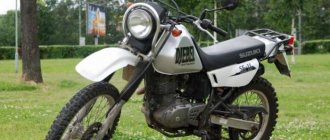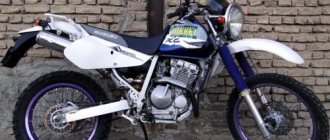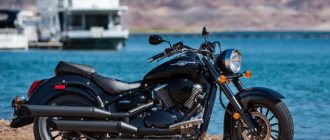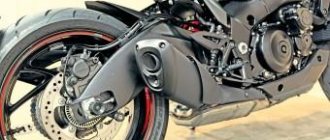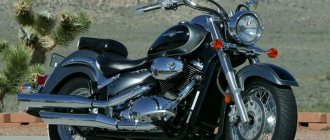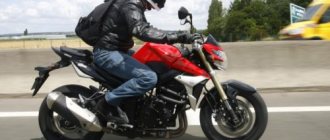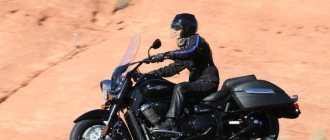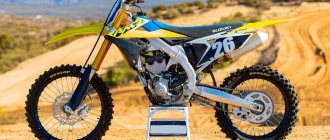| Suzuki Djebel 200 (SE-I) 1993-2005 | Suzuki DR200SE 1996-2013 | Suzuki DR200S 2015+ |
Light enduro model Suzuki Djebel 200
appeared in 1993 as a replacement for the obsolete Suzuki SX200R model and was available in the domestic Japanese market.
In 1995, an export version of the motorcycle appeared, intended mainly for the markets of North America and Oceania - Suzuki DR200SE
. Both models were technically identical, but differed visually - the Djebel 200 had a round headlight with metal protection, the DR200SE was equipped with a traditional enduro rectangular headlight in a plastic housing. The Japanese version (Djebel 200) was produced until 2005 inclusive, after which it was discontinued; an export version (DR200SE) was available on the market until 2013.
The Suzuki Djebel 200 (DR200SE) was based on a 1-cylinder, 4-stroke, 2-valve, air-cooled engine with a capacity of 199 cc. see, producing 20 hp. power and about 18 Nm of torque. Maximum engine performance is at 7000-8500 rpm.
Other features include a steel frame, long-travel suspension in the form of a conventional telescopic fork at the front and a rear monoshock absorber, front disc brakes (drum at the rear), a 13-liter fuel tank, a 5-speed gearbox and 121-126 kg curb weight (depending on versions).
On the Russian market there are mainly domestic Japanese versions (Suzuki Djebel 200), while export ones (Suzuki DR200SE) are practically never found. This is mainly due to the large selection of domestic modifications available at the relevant auctions and the relative ease of delivery from Japan (compared to North America).
2013 was the last year of production of the Suzuki DR200SE model. In 2015, Suzuki introduces a new model called Suzuki DR200S
, which is essentially a slight restyling of the previous Suzuki DR200SE.
The “big brother” of the model is the Suzuki Djebel 250.
The main competitors of the Suzuki Djebel 200 in the class:
- Yamaha Serow 250 / Yamaha Serow 225 (XT225)
- Kawasaki KL250 Super Sherpa
Brief history of the model
- 1993 - start of production and sales of the domestic Japanese model Suzuki Djebel 200. First generation: “SE-I” sticker and square headlight protection.
Model:
Suzuki Djebel 200 (Japan).
Frame number:
SH42A-100001 to SH42A-103935.
Factory designation:
DR200SEP.
- 1994 - no significant changes.
Model:
Suzuki Djebel 200 (Japan).
Frame number:
SH42A-103396 to SH42A-105800.
Factory designation:
DR200SER.
- 1995 - appearance of the export modification Suzuki DR200SE. The Japanese version is released without significant changes.
Model:
Suzuki Djebel 200 (Japan).
Frame number:
SH42A-105801-.
Factory designation:
DR200SES.
- 1996 - The Japanese version of the Suzuki Djebel 200 is released in the second generation: “SE-II” sticker and round headlight protection.
Model:
Suzuki Djebel 200 (Japan).
Factory designation:
DR200SET.
- 1997 - export version available on the market of North America (USA, Canada) and Oceania (Australia, New Zealand, etc.).
Model:
Suzuki Djebel 200 (Japan).
Frame number:
SH42A-109300-.
Factory designation:
DR200SEV.
Model:
Suzuki DR200SE (North America, Oceania).
Factory designation:
DR200SEV.
- 1998 - no significant changes.
Model:
Suzuki Djebel 200 (Japan).
Frame number:
SH42A-112424-.
Factory designation:
DR200SEW.
Model:
Suzuki DR200SE (North America, Oceania).
Factory designation:
DR200SEW.
- 1999 - no significant changes. Factory designation:
DR200SEX. - 2000 - no significant changes.
Model:
Suzuki Djebel 200 (Japan).
Frame number:
SH42A-114262-.
Factory designation:
DR200SEY.
Model:
Suzuki DR200SE (North America, Oceania).
Factory designation:
DR200SEY.
- 2001 - no significant changes. Factory designation:
DR200SEK1. - 2002 - no significant changes. Factory designation:
DR200SEK2. - 2003 - no significant changes.
Model:
Suzuki Djebel 200 (Japan).
Frame number:
SH42A-120001-.
Factory designation:
DR200SEK3.
Model:
Suzuki DR200SE (North America, Oceania).
Factory designation:
DR200SEK3.
- 2004 - no significant changes. Factory designation:
DR200SEK4. - 2005 - no significant changes. Factory designation:
DR200SEK5. The Japanese version of the Suzuki Djebel 200 is being discontinued. - 2006 - no significant changes. Factory designation:
DR200SEK6. - 2007 - no significant changes. Factory designation:
DR200SEK7. - 2008 - no significant changes. Factory designation:
DR200SEK8. - 2009 - no significant changes. Factory designation:
DR200SEK9. - 2010 - no significant changes. Factory designation:
DR200SEL0. - 2011 - no significant changes. Factory designation:
DR200SEL1. - 2012 - no significant changes. Factory designation:
DR200SEL2. - 2013 - no significant changes. Factory designation:
DR200SEL3. The export version of the Suzuki DR200SE is being discontinued. - 2015 - the appearance of a new generation with the name - Suzuki DR200S. Factory designation:
DR200SL5. - 2016 - no significant changes. Factory designation:
DR200SL6. - 2017 - no significant changes. Factory designation:
DR200SL7. - 2018 - no significant changes. Factory designation:
DR200SL8. - 2019 - no significant changes. Factory designation:
DR200SL9. - 2020 - no significant changes. Factory designation:
DR200SM0. - 2021 - no significant changes. Factory designation:
DR200SM1.
Does color matter?
At first, the motorcycle was in demand mainly among the rural population, then they began to paint it in brighter colors and the situation leveled off; the Jebel 200 was now also purchased by urban residents. Of course, each buyer had his own stereotypical approach, some liked the orange camouflage, while others preferred more modest colors. However, everyone agreed on one thing - both villagers and city dwellers would like to purchase a reliable, trouble-free motorcycle, and what color, this can be discussed later.
The bike was produced for some time as the Jebel 250, but soon production completely switched to the Jebel 200, since the fuel savings were significant. And this option turned out to be the most successful, the production of the “200th” continued for quite a long time, and not only for reasons of low gasoline consumption - there were also a number of arguments in favor of the “200th”, one of which was the reliability of the design.
The motorcycle was not intended for racing either around the circuit or over rough terrain. It was a simple machine for easy operation under normal conditions. However, it turned out to be difficult to resist rushing along a good highway, especially for a young motorcyclist. The speed of the Jebel 200 was decent and was about 180 km per hour. Some owners even organized mini-competitions among themselves, just to test the technical capabilities of the car. And the motorcycle never let me down.
Specifications
Technical characteristics of Suzuki Djebel 200 / DR200SE / DR200S:
| Model | Suzuki Djebel 200 - Japanese version Suzuki DR200SE - export version Suzuki DR200S - modern generation |
| Motorcycle type | enduro |
| Year of issue | 1993-2005 - Djebel 200 1995-2013 - DR200SE 2015+ - DR200S |
| engine's type | 1-cylinder, 4-stroke |
| Working volume | 199 cm³ |
| Cooling | air |
| Bore/Stroke | 66 x 58.2 mm |
| Compression ratio | 9,4:1 |
| Number of valves per cylinder | OHC, 2 valves |
| Fuel supply system | carburetor, 1x Mikuni BST31 |
| Ignition type | fully transistorized |
| Maximum power | 20 hp at 8500 rpm |
| Maximum torque | 17.65 Nm at 7000 rpm |
| Clutch | Multi-disc in oil bath, cable drive |
| Transmission | 5-speed |
| type of drive | chain |
| Frame | steel |
| Front suspension | telescopic fork, stroke - 205 mm |
| Rear suspension | Pendulum with monoshock absorber (preload adjustment), stroke - 205 mm |
| Front tire size | 70/100-21M/C 44P |
| Rear tire size | 100/90-18M/C 56P |
| Front brakes | 1 disc, 230 mm, 1-piston caliper |
| Rear brakes | drum, 130 mm |
| Motorcycle length | 2150 mm 2155 mm – DR200S |
| Motorcycle width | 805 mm |
| Motorcycle height | 1150 mm – Djebel 200 1185 mm – DR200SE 1140 mm – DR200S |
| Seat height | 810 mm 845 mm – DR200S |
| Wheelbase | 1405 mm |
| Minimum ground clearance (clearance) | 260 mm 255 mm – DR200S |
| Acceleration 0-100 km/h (0-60 mph) | 13.62 sec[1] |
| Maximum speed | 115 km/h[2] |
| Gas tank capacity | 13 L 12.5 L - DR200SE (California) |
| Motorcycle weight (dry) | 108 kg - Djebel 200 113 kg - DR200SE |
| Motorcycle weight (curb) | 121 kg - Djebel 200 126 kg - DR200SE, DR200S |
Service as it is
The popularity of the car was facilitated by the wide technical service network that it deployed throughout Europe. Thus, there was no question of spare parts; any parts could be obtained within an hour, and repairs and replacements did not pose any problem, since qualified specialists were ready to work everywhere. Among other things, the motorcycle was structurally simple, without any frills. The owners could easily carry out many of the actions associated with minor repairs on their own without much difficulty if they had the simplest tool, a hammer, a set of keys and other devices at hand.
Suzuki Djebel 200 was modified in 1997. The landing was made lower, but the ground clearance remained the same. The coloring was varied. Camouflage in several combinations, silver tank with black trim. Mudguards on both wings, oil radiator for more efficient engine cooling. Export name - "Troyan-200". Some skeptics doubted the word “Trojan”, because everyone knows the story of the Trojan horse. Is there some kind of catch here too, buyers asked each other. However, the very first kilometers behind the wheel of a comfortable, dynamic motorcycle dispelled all doubts.
Reviews
Reviews about Suzuki Djebel 200:
Expand Collapse
I actively use it in the Crimean mountains and on the roads. Great motorcycle for the money. I bought it for 1850 green. I immediately changed the chain, sprockets, oil, both filters and wheel bearings. Everything else is in excellent condition. So far, even in Crimea, I haven’t found that hill that he doesn’t pull me into. Just right for small trips. Taking into account its consumption of 3.5 liters. Regarding the range on it. I bought it in Kyiv and drove it to Simferopol myself. I left at 6 am and was at home at 4 pm. 850 km approximately. I kept an average speed of 95 km (I tried 100). I drove in the mode - refueling - full tank - 5 minutes of coffee, refueling - full tank - 5 minutes of coffee, refueling - full tank - 5 minutes of coffee, refueling - full tank - 5 minutes of coffee. I didn't rest for more than 15 minutes. Normal even with my weight of 125 kg. But I’m used to long-distance riders since the YAMAHA YBR-125 motorcycle.
The mot is absolutely cool!!! I went for a season (364 days)))) I was just happy!!! despite the fact that I got the motorcycle at an expensive price and with a defect!!! and then I completely screwed it up (due to inexperience) Now I’m taking a TTR Reid and still restoring the dowels, for my wife! (but it seems to me that I will ride it more often than she))) The bike is cool but unique!!!
If you chose the right motorcycle, it is a very good one.
The season is over.
On the one hand, I want to replace it and try others, but I can’t find something else that suits my needs. For me Jebel 200 was the best. Pros:
- Light, with a very low first and good lows. On standard chainrings it goes slowly, where others either need to rush or burn the clutch.
— Low, on the slopes this is a big plus.
— The saddle is not very narrow if you ride alone.
— The tank is spacious, the range at one fill-up is large.
- Narrow, in the city, in traffic jams, where everyone stands.
— Headlight excellent, trunk.
— In winter there are rear brakes.
- Simple and reliable. If not killed.
Minuses:
- Lightweight, blows away on the highway. It’s scary to leave it in the yard; 2 people can easily pick it up and carry it away.
— It seems that the front fork is weak, maybe there is not enough power.
— You can drive on the highway, but not very well. Nice. After 80 the dynamics are sluggish and slow.
— Engine life is less than 250
The purpose of this motorcycle is for medium-distance travel. This is a very light touring bike. It turns out that he has no competitors.
It seems you can take Jebel 250, it’s ideal for travel, but the weight increase and the price are 80% more expensive than Jebel 200.
Many take two hundred, as well as 250 Jebel for riding around the surrounding area. That's why they sell it afterwards. You can ride them around the surrounding area, but they are more for “tramps.” It’s not for nothing that the tanks have the inscription “for tourism.”
They brought me Susie DJEBEL 200 (the name was given) 2 weeks ago from Japan. I live in a small town in the Moscow region. 50 km from Moscow Ring Road. forest nearby. fields nearby. this is a good mot. '98 but I'll give 2005-7. Everything is OK. On the highway it’s hard with the brakes and you have to make calculations for overtaking in advance. but if you work only with speeds, then the problem disappears. He's running around the field like that! that you wonder where the aisle and the fall are. ))))) I paid 150,000 and I’m happy as hell. this is not a spendthrift. this is a car.
Photo gallery
Our selection presents a small-capacity motorcycle belonging to the enduro class. Its appearance is simple and compact, but as we have already found out, the Djebel 200 is a very reliable and popular motorcycle. Without a doubt, you can go on a trip with it.
002_MOTO_0310_041
Suzuki Djebel 250 XC. Suzuki Djebel 250 XC.
BUY "MOUNTAIN". A “dowel” from the first years of production, which has traveled dozens of kilometers across Russia and has changed several owners, but without any special technical problems can be bought for 80–90 thousand rubles; for copies of the last years of production with a range of several thousand kilometers they ask for 150–170 thousand roubles. - this is the ceiling of the price range. Traditionally, the Japanese use “chekushko-enduras” mainly as a means of transportation on roads, and not for conquering off-road terrain, so even ten-year-old vehicles “fresh from Japan” have practically no external defects (except for rust on steel parts from long-term storage in the open air). sky), and the insides, as a rule, are not tortured. The devices “used in Russia” come across very different - from complete “firewood” to completely well-groomed motos. And the price for copies already “registered” in the country in most cases depends more on the technical condition than on the year of manufacture. However, the modernized Djebel, released after 2000, is the best choice today.
Distinctive features of the bike
For a long time, the Jebl 250 motorcycles and its brother DR250R were assembled at the same time and therefore they have a lot in common - the engine, the suspension. There are no significant differences between them - the only difference is that the Djebel 250 has a larger headlight and the tank has become much more spacious (the DR series had a small square headlight).
Price policy
The cost of the bike can scare an ignorant motorcyclist, and this is taking into account the fact that all enduro motorcycles are not a cheap pleasure. But when you get behind the wheel for the first time and drive a few kilometers, you realize that it’s worth it. Today, new Suzuki Jebels can no longer be found (they are no longer produced), you will have to look among used bikes.
Models released in the 90s can be found for 90 thousand rubles. But due to their specialization, they will most likely be in terrible condition. If we talk about Suzuki enduro, produced in 2000 and older, then their cost increases noticeably - from 130 to 200 thousand rubles.
Tuning – creativity with Suzuki Jebel 250
Any bike can be customized - some strive for comfort, some make it faster or more manageable. To make the Suzuki Djebel 250 unique in its kind, professionals do the following:
- Installation of a new tank. If you're a fan of long-distance off-road travel, then a larger tank is for you. Experienced travelers install tanks with a volume of 25-30 liters on Jebel;
- When driving in particularly dangerous and impassable places, many rely on crankcase protection. Such luxury on average costs no more than 7 thousand rubles;
- Windshield (installed rarely and mainly by amateurs);
- Lever protection. In case of an unsuccessful fall, you can break the brake or clutch handle, which will be extremely unpleasant. That is why many extreme athletes play it safe and install additional protection. Some long-distance travel enthusiasts may find wind deflectors on levers useful;
- If the saddle of this enduro does not suit you for some reason, you can replace it with a more comfortable one (there are basic ones, and there are custom versions of the saddles).
In general, there are many options for improving the bike. We have given only a number of examples to awaken the imagination of motorcycle lovers and see what they are willing to do for the sake of their “steel horses”.
To summarize, I would like to say that this motorcycle is the best in its class for a number of reasons. If you buy such a motorcycle, you definitely won’t regret your choice.
Advantages of Jebel - we consider all options
In order for a biker to understand why Djebel is so attractive for motorcyclists, let’s consider all its advantages:
- Unlike all sorts of competitors, on Jebel it is necessary to change the oil every 5000 km. With proper operation and timely maintenance, it can be driven from up to 150,000 km without major repairs. Another plus is the rigid frame, which perfectly withstands serious accidents, falls and impacts;
- On Jebel you can safely cover huge distances even on asphalt! Thanks to a comfortable seat, a spacious tank and even a trunk, a trip to a neighboring city will seem like a pleasant walk. Experts defined this enduro as excellent. The bike runs smoothly both on dirt and asphalt;
- The bike's ground clearance is equal to 30 cm, then the suspension is 28 cm. With such indicators, such obstacles as bumps and holes will become simply invisible.
Now regarding the shortcomings of the Suzuki Jebel 250:
- If the rear brake breaks, then that's it, we're done. The design of the bike is such that it cannot be repaired;
- Sometimes the footrest sensor gets “naughty”. When the step is thrown out, the engine is automatically turned off, which is extremely convenient for beginners. But sometimes, when riding over serious obstacles, it starts to work automatically and turn off the engine - this can create a number of problems for experienced bikers (which is why they get rid of it).
Otherwise the bike is just perfect.
006_MOTO_0310_042
The oil cooler becomes clogged with dirt flying from the front wheel, but this has almost no effect on engine cooling.
The oil cooler becomes clogged with dirt flying from the front wheel, but this has almost no effect on engine cooling. The old TM28 carburetor is often criticized for its “low-end failure” and praised for its “sporty top end.” The new BSR32, on the contrary, is “lucky” from the “bottom” and slows down at the “top”. In fact, the old carburetor is not so bad, you just need to correctly adjust the idle speed - and according to the factory recommendation, they are quite high - 1500-1700 (!) rpm. Therefore, if you hear individual flashes when purchasing, do not hesitate to set the “threshing” speed before the trip. With both carburetors, fuel consumption on the highway is within 4–5 l/100 km, i.e. The tank lasts for 300–400 km.
But the most effective means of fighting for traction at the bottom remains “playing” with the stars. The standard 14-42 kit is more or less suitable only for asphalt driving. For light plein air rides mixed with asphalt, the optimal ratio is 13–42, and for hard off-roading and fully loaded outings, we can recommend 13–49—the standard option for the DR-Z250. However, in the latter case, you will need to remake the chain trap. Another bonus for “dowel drivers” is that the drive sprocket is fixed on the gearbox shaft with a simple retaining ring, and not with bolts or a nut, as on most endurics, so replacing it in the field will only require the presence of a retaining ring remover (pliers). The whole operation takes about five minutes, including resetting the chain tension.
You can often hear negative feedback about the operation of the gearbox: it shifts hard, the neutral is difficult to catch... In the vast majority of cases, this is not a design flaw or wear and tear. The “dowel” box is extremely sensitive to the quality of the oil, and its jamming is the first sign that it is time to change the oil. The approximate service life of “synthetics” is 3–5 thousand km, semi-synthetics – up to 3 thousand km. But in hard off-road conditions, of course, you need to do this more often. Another feature of the gearbox is reliable gear locking. It not only allows you to avoid accidental switching while driving (and this is very unpleasant on off-road), but also saves the box itself from overloads
When checking the motorcycle while driving, pay attention to the operation of the speedometer. At the “dowel” it is driven by a cable, which often breaks
But this is not so bad - a modified cable from a VAZ-2107 (70 rubles) is suitable for replacement, but the crumbled gears of the gearbox will require replacement of the assembly. This is a reason for bargaining.
Description
The Suzuki Djebel 200 motorcycle model first appeared on the domestic Japanese market in 1993 as a replacement for the obsolete Suzuki SX 200 R model. In foreign markets, the Suzuki Djebel 200 was produced under the name Suzuki DR 200 SE. The model lasted until 2005, after which it was officially discontinued and was no longer sold. Suzuki Djebel 200 is a dual-purpose motorcycle designed for movement on surfaces of any quality and any coating. The model is simple, reliable and easy to maintain.
005_MOTO_0310_042
After modernization in 2000, Djebel acquired a constant vacuum carburetor, and a kickstarter became standard. After modernization in 2000, Djebel acquired a constant vacuum carburetor, and a kickstarter became standard.
The Djebel engine, like many Suzuki air vents, is noisy. When you stop, sometimes you hear a terrible clattering noise - this is also normal, don’t worry. The engine has an automatic decompressor installed, so it will not be possible to measure the actual compression in the cylinder. The only way to check is on the go (of course, if you have enough experience in your arsenal and the owner allows it). In general, the engines run here for a very long time (there is experience of 100–150 thousand km), but they are demanding on the quality of oil and air (the cylinder is nickel-silver). Therefore, keep an eye on the air filter (it is impregnated with foam rubber). And the slightest noticeable leaks at the inlet are a reason to refuse the purchase. Valve clearances are adjusted with washers (they will have to be ordered after measuring the clearances), but the complexity of adjustment is compensated by its relatively rare need (as a rule, this is 20–40 thousand km). By the way, a leaking cylinder head gasket usually indicates that the head has been opened.
004_MOTO_0310_042
In addition to the usual functions, the trip computer has two resettable odometers with the ability to count down kilometers and a stopwatch with a timer. In addition to the usual functions, the trip computer has two resettable odometers with the ability to count down kilometers and a stopwatch with a timer.
“Snotty” front fork seals are not a problem, replacing them does not promise problems or special financial costs, you just need to make sure that the working surface of the stays does not have scuffs or severe wear (the fork is very expensive). But a “snotty” rear shock absorber (or, even worse, with traces of corrosion on the rod) is a reason for serious bargaining. Unlike most sports enduros, the “limited” unit is considered non-separable, therefore, repair kits for it are not sold and it can only be replaced entirely and at great cost. Of course, folk craftsmen have recipes for handicraft repair of a unit, but it will not become new - in any case, its service life is no longer the same (a new one can last 30-70 thousand km). The first sign of problems is the appearance of free play in the upper position. Lift the rear of the motorcycle and rock it. Is there any play? This means that gas has escaped from the compensation tank. And a chamber valve embedded in the lid of the tank (for pumping) is a sure sign of disassembly of the unit. The remaining components of the rear suspension do not cause any complaints and can serve for a very long time, incl. due to the presence of grease nipples in each of the four joints (pendulum axis and “progression”).
SMALL JOYS AND SMALL DISGUSTS. An undeniable advantage of the Suzuki Djebel is the ability to adjust the height of the shock absorber. By installing its lower mount in one of two possible positions, you can change the height of the saddle by a couple of centimeters. And if you order an original saddle with a low profile from Japan, the motorcycle will fit even “inches.” The height of the front end can also be changed a little by moving the forks in the traverses. In addition, there are “high” and “low” forks, differing in height (and travel) by about 4 cm. A “high” fork can easily be converted into a “low” one by removing the spacer above the spring rod (to access it, just unscrew the strut plug ).
